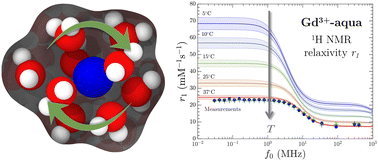Thermal and concentration effects on 1H NMR relaxation of Gd3+-aqua using MD simulations and measurements†
Abstract
Gadolinium-based contrast agents are key in clinical MRI for enhancing the longitudinal NMR relativity (r1) of hydrogen nuclei (1H) in water and improving the contrast among different tissues. The importance of MRI in clinical practice cannot be gainsaid, yet the interpretation of MRI relies on models with severe assumptions, reflecting a poor understanding of the molecular-scale relaxation processes. In a step towards building a clearer understanding of the relaxation processes, here we investigate thermal and concentration effects on r1 of the Gd3+-aqua complex using both semi-classical molecular dynamics (MD) simulations and measurements. We follow the MD simulation approach recently introduced by [Singer et al., Phys. Chem. Chem. Phys., 2021, 23, 20974], in which no NMR relaxation model or free-parameter is assumed to predict r1, thereby bringing new insights into the physics of r1 on a molecular scale. We expand the autocorrelation function G(t) in terms of molecular modes and determine the thermal activation energies of the two largest modes, both of which are consistent with the range of literature values for rotational diffusion. We also determine the activation energies for translational diffusion and low-field electron-spin relaxation, both of which are consistent with the literature. Furthermore, we validate the MD simulations at human body temperature and concentrations of the paramagnetic ion used in clinical MRI, and we quantify the uncertainties in both simulations and measurements.



 Please wait while we load your content...
Please wait while we load your content...